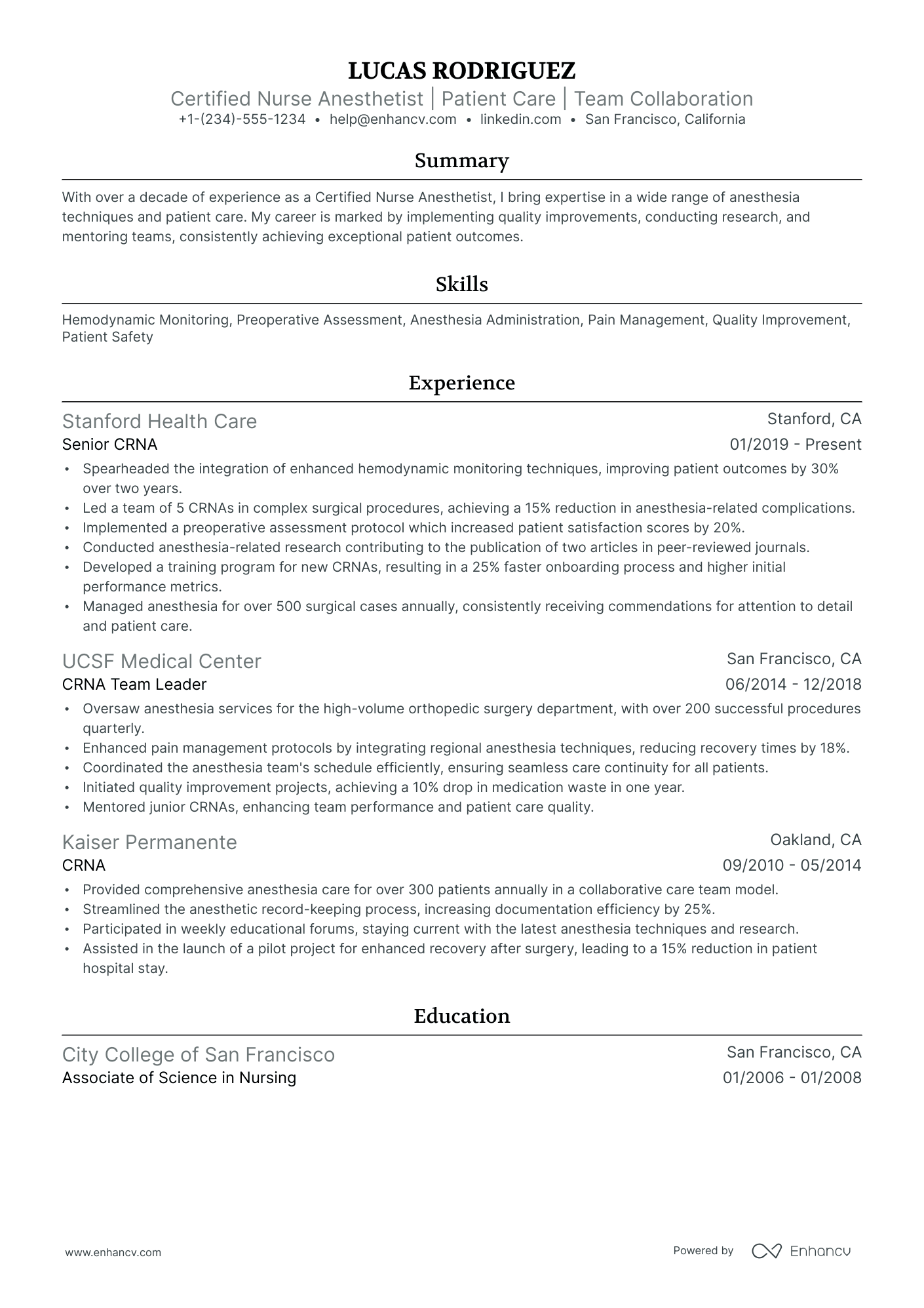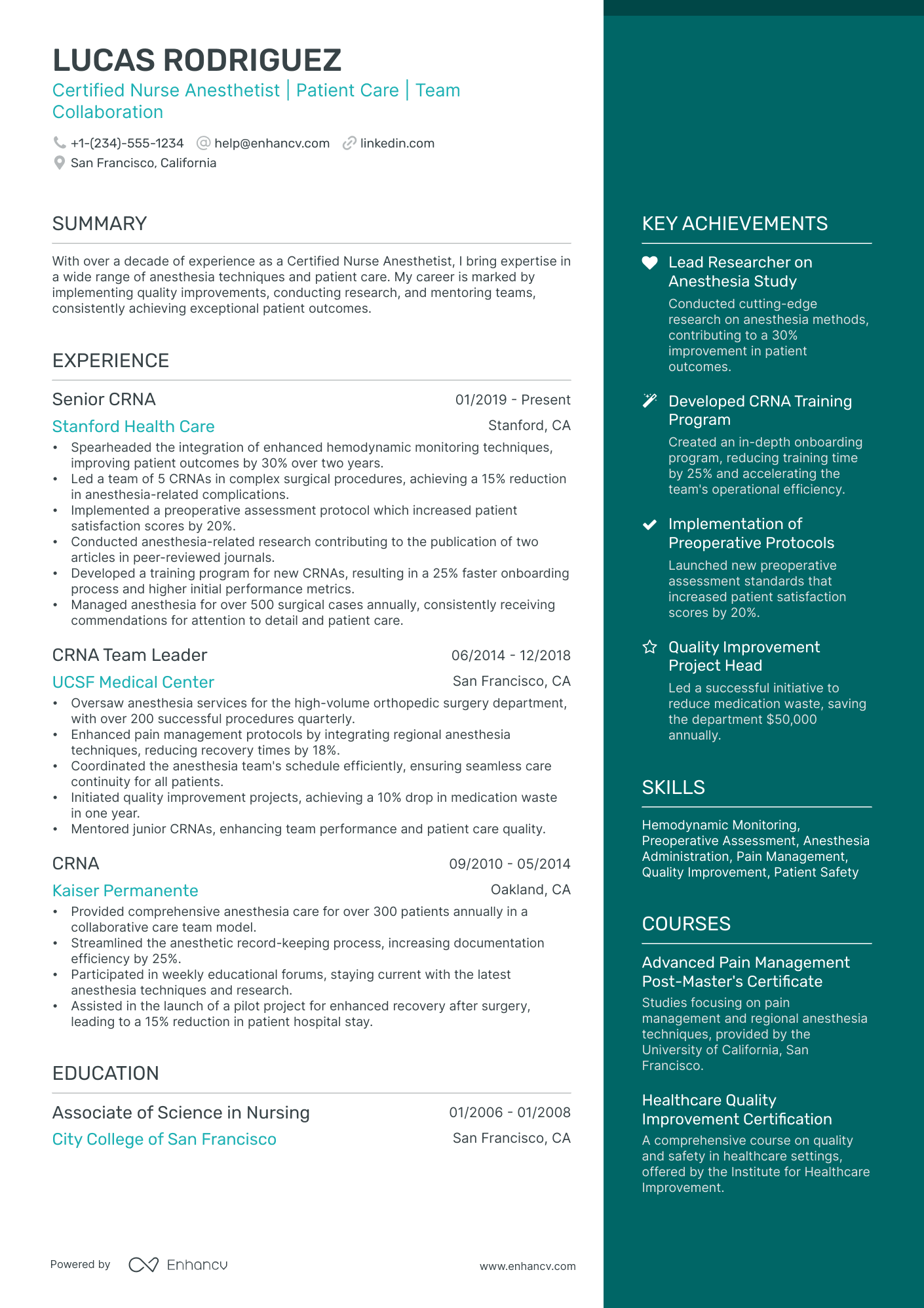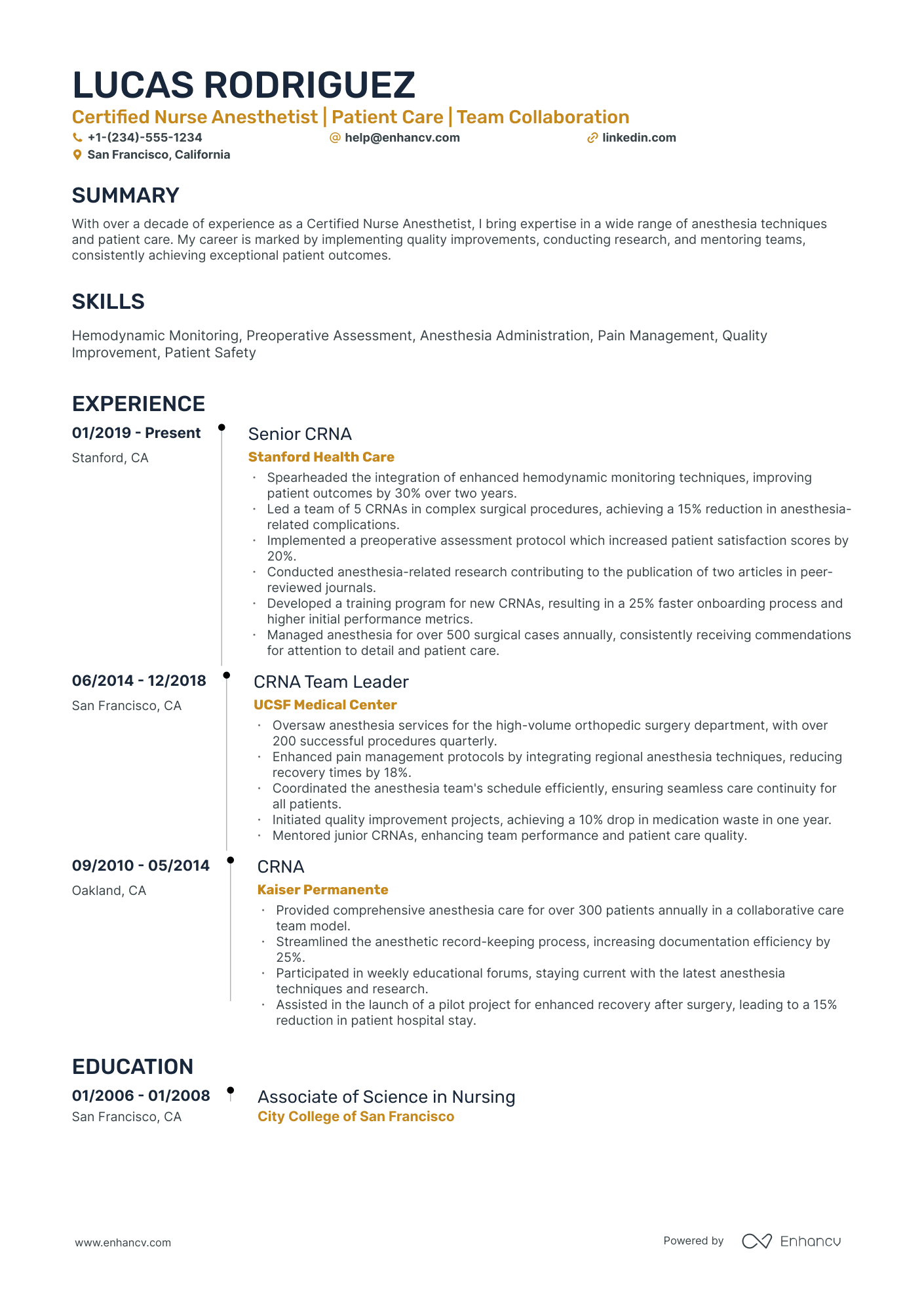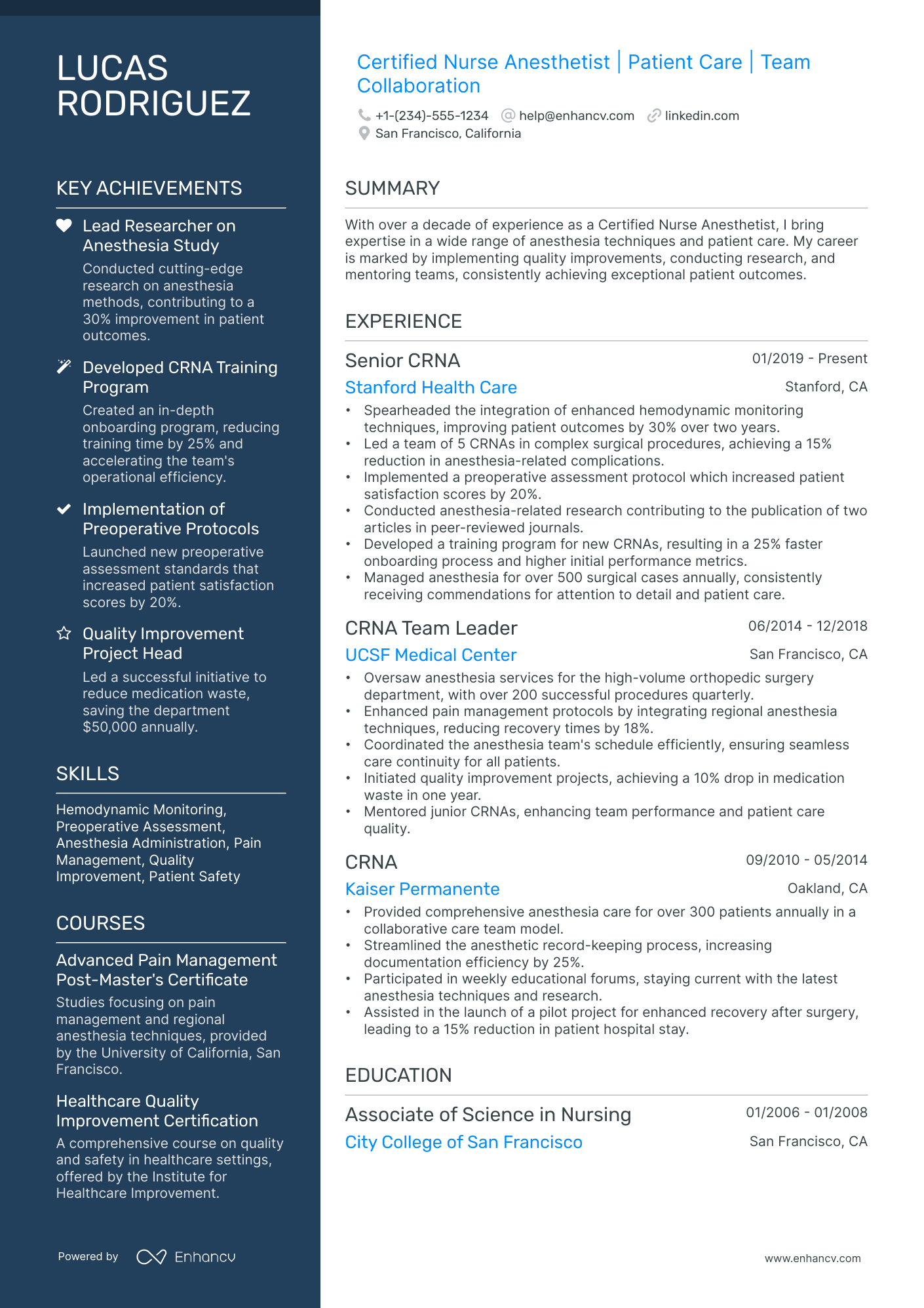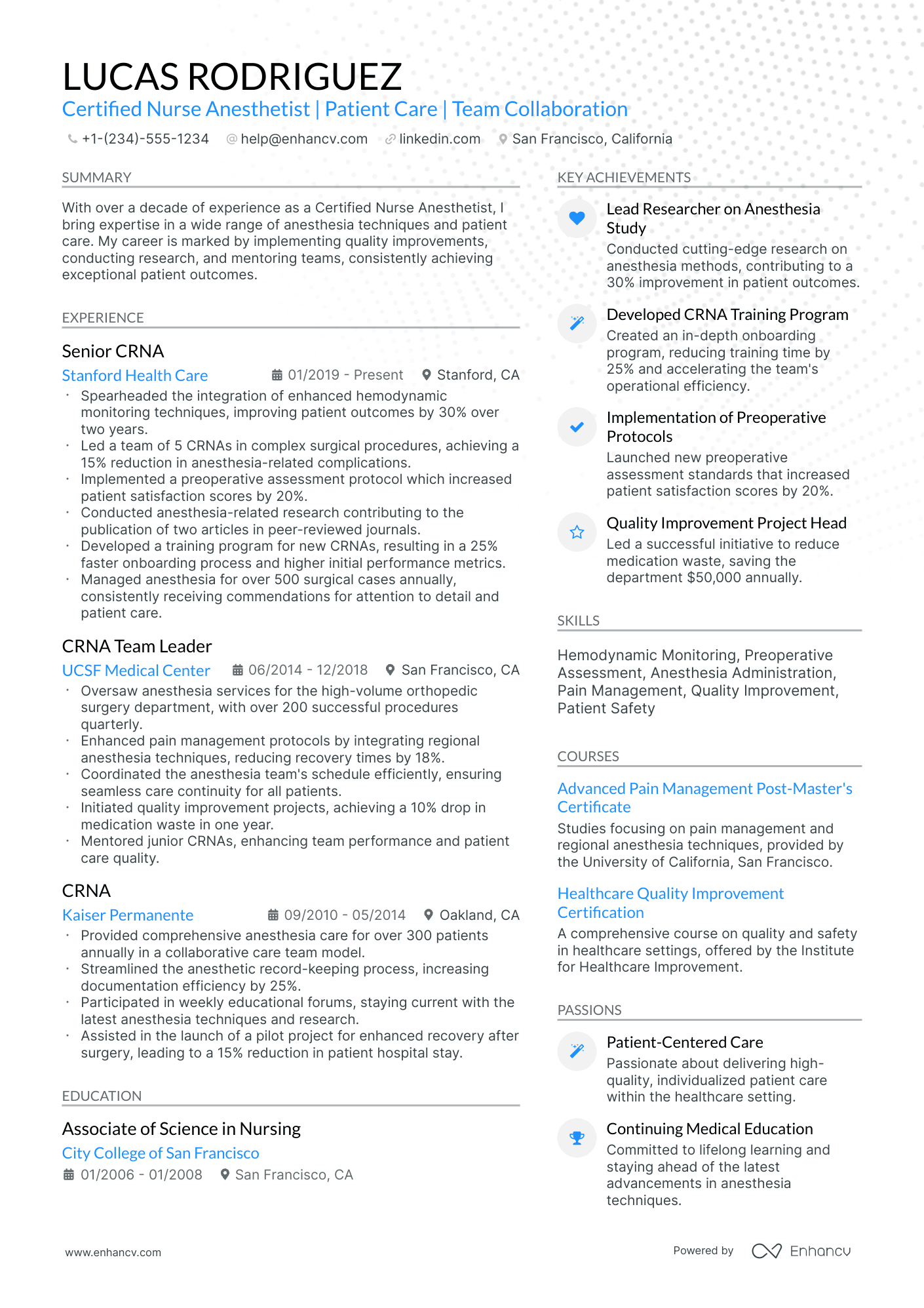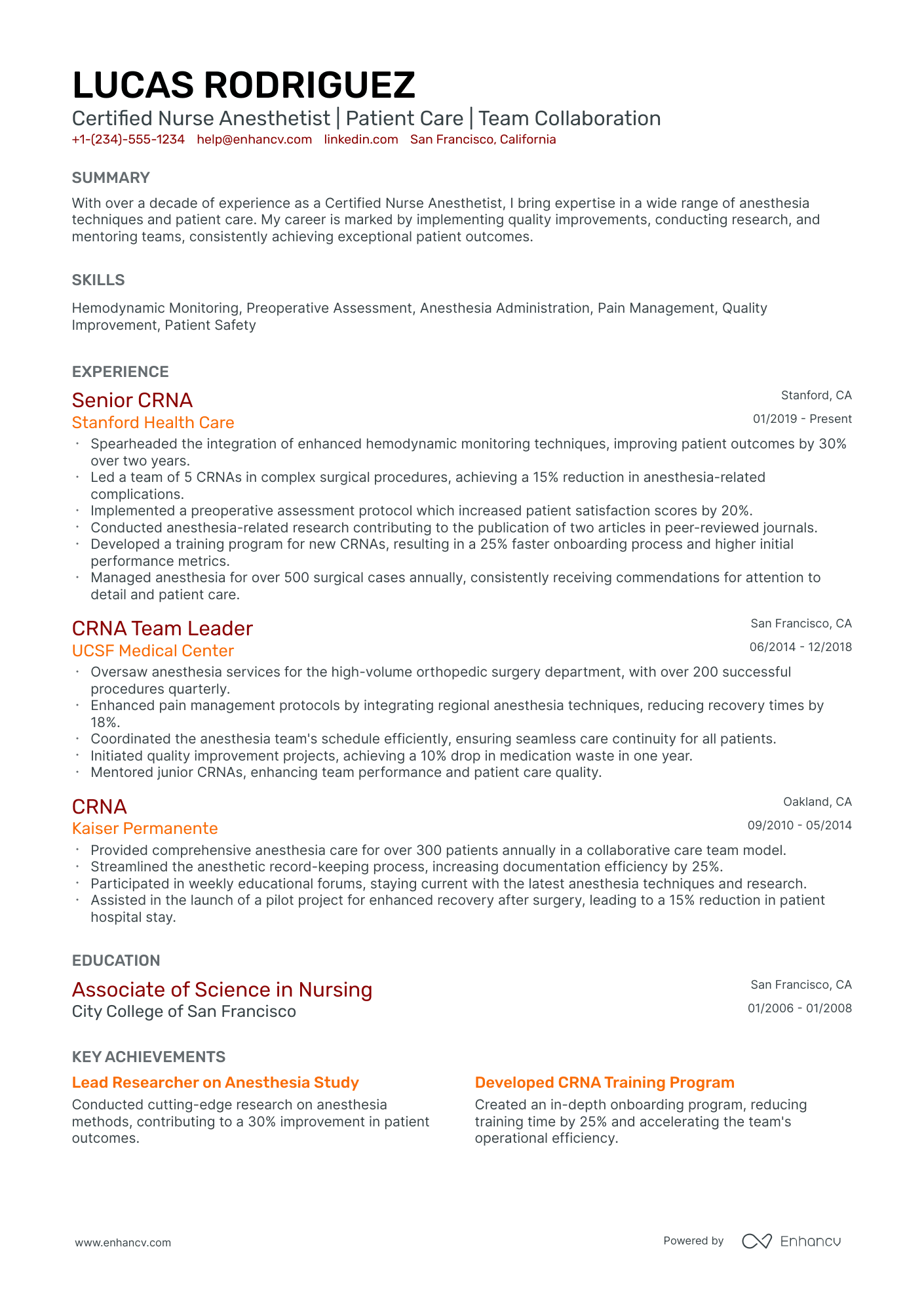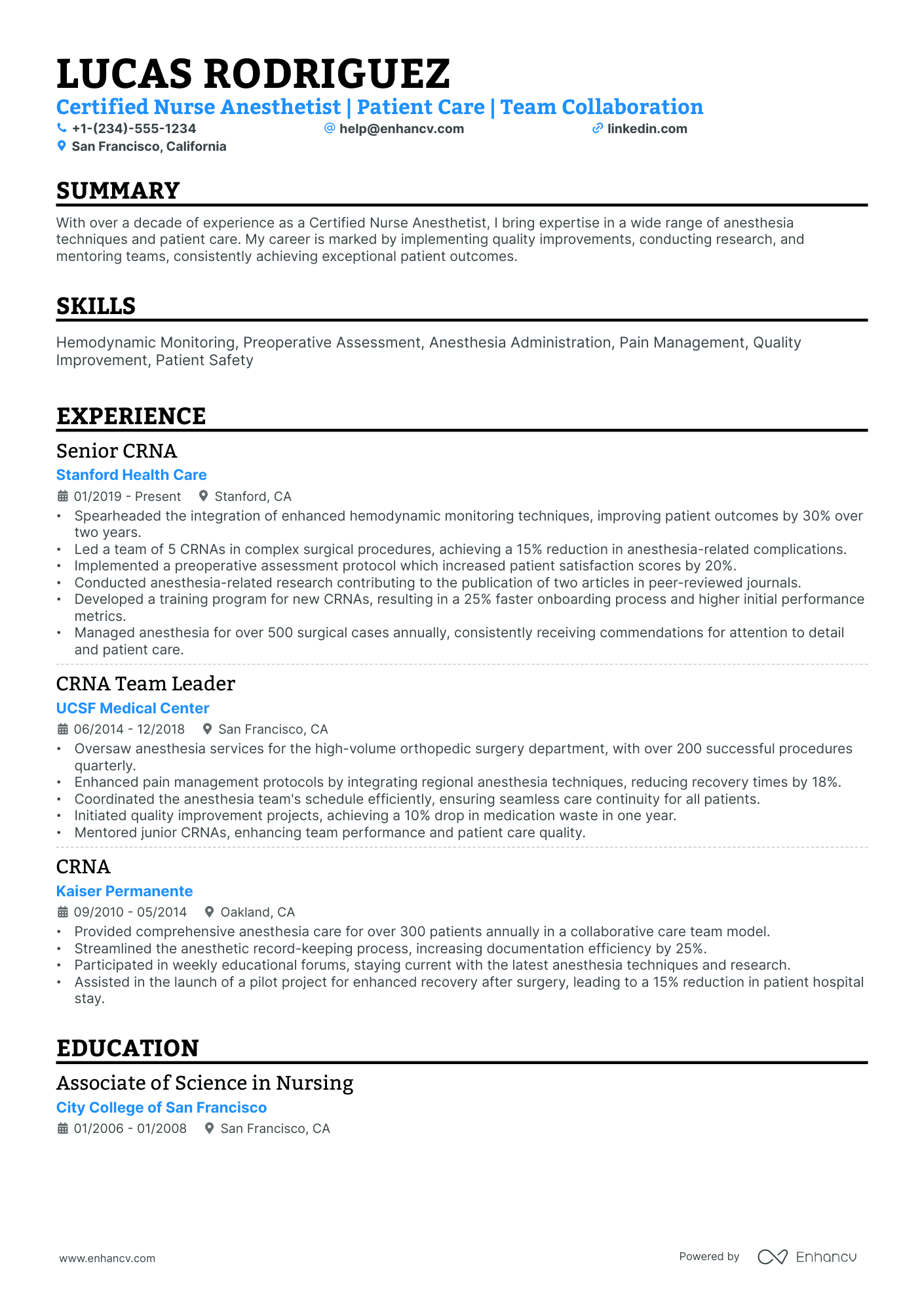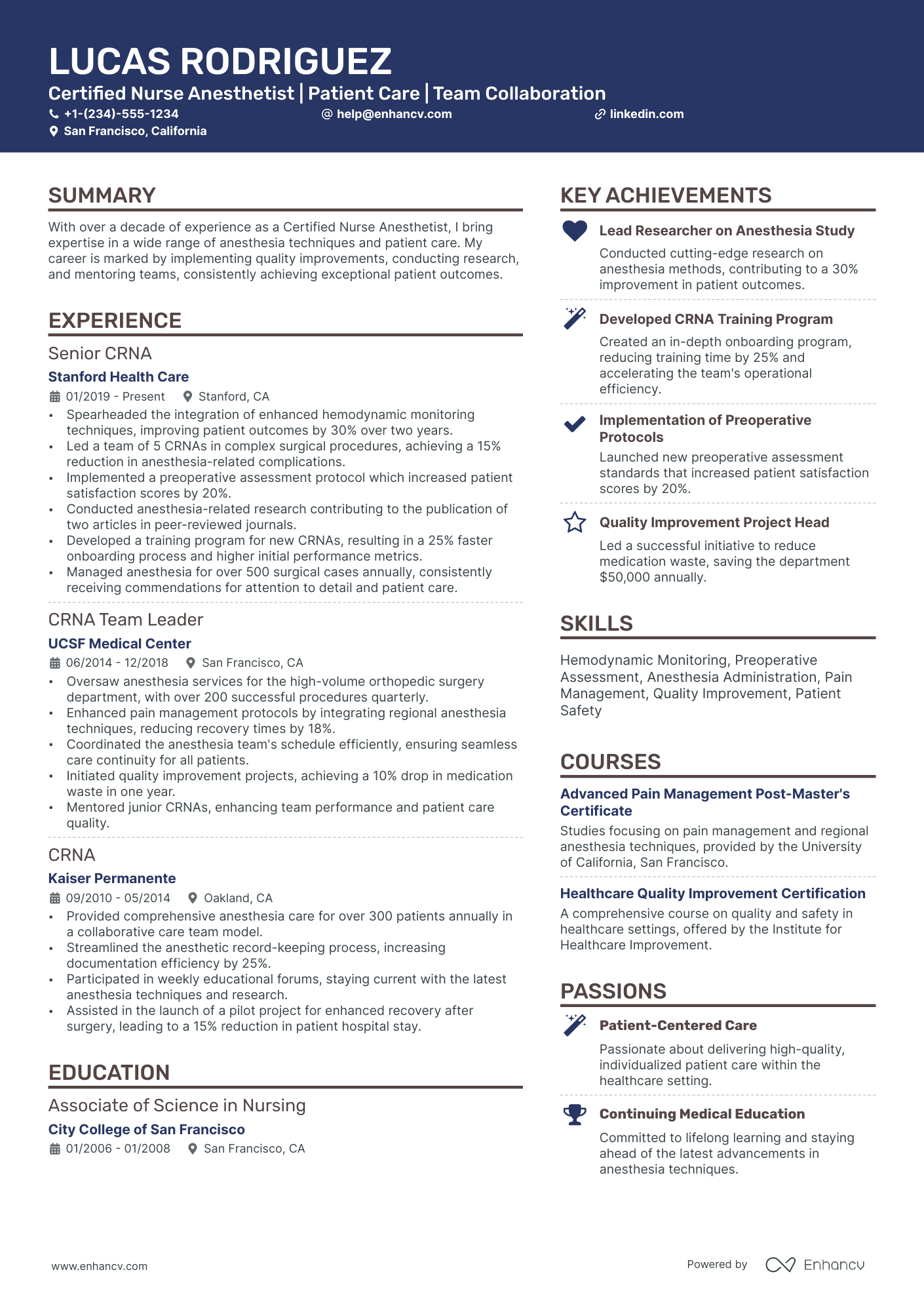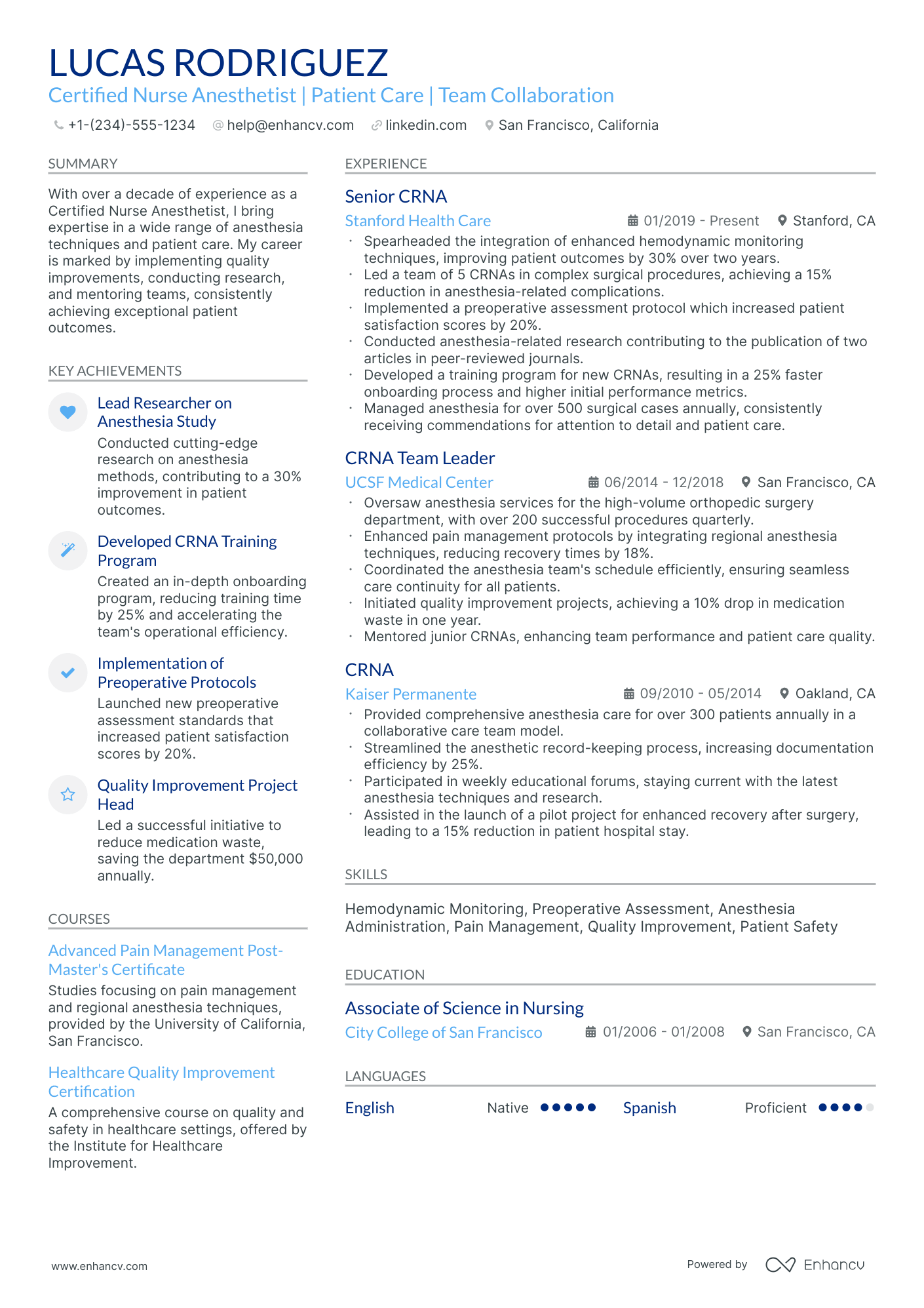As a nurse anesthetist, you might find it challenging to effectively distill your extensive clinical experience and specialized training into a concise resume that stands out. Our guide provides tailored strategies and examples to help you articulate your unique qualifications and achievements, ensuring your resume captures the attention of potential employers.
- Nurse anesthetist resumes that are tailored to the role are more likely to catch recruiters' attention.
- Most sought-out nurse anesthetist skills that should make your resume.
- Styling the layout of your professional resume: take a page from nurse anesthetist resume examples.
How to write about your nurse anesthetist achievements in various resume sections (e.g. summary, experience, and education).
Best practices for the look and feel of your nurse anesthetist resume
Before you even start writing your nurse anesthetist resume, first you need to consider its layout and format.
What's important to keep in mind is:
- The reverse-chronological resume is the most widely used format to present your experience, starting with your latest job.
- Your nurse anesthetist resume header needs to include your correct, professional contact details. If you happen to have a professional portfolio or an updated LinkedIn profile, include a link to it.
- Ensure your resume is no longer than two pages - you don't have to include irelevant experience on your resume just to make it look longer.
- Unless specified otherwise, submit your resume in the most popular format, the PDF one, as this will ensure your nurse anesthetist resume isn't altered.
Customize your resume for the market – a Canadian format, for example, might vary in structure.
Upload & Check Your Resume
Drop your resume here or choose a file. PDF & DOCX only. Max 2MB file size.
PRO TIP
List your educational qualifications and certifications in reverse chronological order.
Traditional sections, appreciated by recruiters, for your nurse anesthetist resume:
- Clear and concise header with relevant links and contact details
- Summary or objective with precise snapshot of our career highlights and why you're a suitable candidate for the nurse anesthetist role
- Experience that goes into the nuts and bolts of your professional qualifications and success
- Skills section(-s) for more in-depth talent-alignment between job keywords and your own profile
- Education and certifications sections to further show your commitment for growth in the specific niche
What recruiters want to see on your resume:
- Certification as a Certified Registered nurse anesthetist (CRNA).
- Graduate of an accredited nurse anesthesia educational program.
- Hands-on clinical experience with anesthesia procedures and patient monitoring.
- Expertise in various anesthesia techniques and anesthetics usage for different types of surgeries.
- Ability to work collaboratively with anesthesiologists, surgeons, and other healthcare professionals.
Quick guide to your nurse anesthetist resume experience section
After deciding on the format of your resume, it's time to organize your experience within the dedicated section.
It's common for nurse anesthetist professionals to be confused in this part of the process, as they may have too much or little expertise.
Follow the general rules of thumb to be successful when writing this part of your resume:
- The perfect number of bullets you should have under each experience item is no more than six;
- Select not merely your responsibilities, but the most noteworthy achievements for each role that match the job requirements;
- List any certificates or technical expertise you've gained on the job and how they've helped you progress as a professional;
- Carefully select the power verbs to go along with each bullet to avoid generic ones like "managed" and instead substitute those with the actuality of your particular responsibility;
- Integrate valuable keywords from the job advert in the form of achievements under each role you list.
If you're on the search for further advice on how to write your nurse anesthetist experience section, get some ideas from real-world professional resumes:
- Effectively led a team of 10 junior CRNAs, providing mentorship and training that improved team efficiency by 25%.
- Managed the anesthesia services for over 300 complex surgical cases annually, maintaining a 99% patient satisfaction rate.
- Spearheaded the adoption of a new patient monitoring system that decreased anesthesia-related complications by 15%.
- Performed an average of 500 anesthetic procedures each year, with a focus on pediatric patients, ensuring a calm and supportive environment.
- Collaborated on a research project evaluating anesthesia outcomes, which was published in a prestigious medical journal.
- Implemented a quality improvement initiative that reduced drug waste by 20%, translating into $50,000 in annual savings.
- Provided anesthetic care in a fast-paced trauma center, efficiently handling emergency situations for an average of 15 cases per week.
- Initiated a peer review process that enhanced the accuracy of anesthesia administration, minimizing errors by 30%.
- Conducted in-service training for surgical staff on new anesthesia protocols, ensuring compliance with latest industry standards.
- Planned and administered anesthesia for over 200 elective surgical cases with a focus on orthopedics and resulting in reduced patient recovery time.
- Actively participated in the rollout of a perioperative surgical home model that improved patient outcomes and satisfaction.
- Developed and led a workshop on opioid-sparing techniques that was adopted hospital-wide.
- Managed a departmental initiative to integrate electronic health records, improving preoperative assessment processes and reducing manual errors by 40%.
- Provided anesthesia for an average of 650 cases per year including high-risk obstetric patients, maintaining a stellar safety record.
- Launched a departmental wellness program that decreased staff turnover by 18% in a two-year period.
- Directed the anesthetic care for transplant surgeries, contributing to a 10% increase in successful outcomes over a four-year period.
- Mentored 15 CRNA students, enhancing their practical skills and contributing to an accelerated 95% pass rate on the national certification exam.
- Coordinated with multidisciplinary teams to develop a streamlined preoperative workflow, cutting patient wait times by 20%.
- Orchestrated the transition to a new anesthesia delivery system, ensuring seamless adoption by the anesthesia team.
- Delivered tailored anesthetic care for neurosurgical operations, enhancing patient neurologic function monitoring during complex procedures.
- Championed an initiative to standardize post-anesthesia care unit handoffs, improving patient information transfer efficiency by 35%.
- Facilitated anesthesia management for cardiac surgery cases, achieving a 98% rate of hemodynamic stability during high-risk procedures.
- Reduced anesthesia induction times by 20% through the development and implementation of a preoperative optimization protocol.
- Organized a symposium on anesthesia for minimally invasive surgery, attracting over 300 healthcare professionals.
The following content includes information from "O*NET OnLine" by the U.S. Department of Labor, Employment and Training Administration (USDOL/ETA). Used under the CC BY 4.0 license. The data represents the top responsibilities present on the task lists for nurse anesthetist professionals.
Top Responsibilities for Nurse Anesthetist:
- Manage patients' airway or pulmonary status, using techniques such as endotracheal intubation, mechanical ventilation, pharmacological support, respiratory therapy, and extubation.
- Respond to emergency situations by providing airway management, administering emergency fluids or drugs, or using basic or advanced cardiac life support techniques.
- Monitor patients' responses, including skin color, pupil dilation, pulse, heart rate, blood pressure, respiration, ventilation, or urine output, using invasive and noninvasive techniques.
- Select, order, or administer anesthetics, adjuvant drugs, accessory drugs, fluids or blood products as necessary.
- Select, prepare, or use equipment, monitors, supplies, or drugs for the administration of anesthetics.
- Assess patients' medical histories to predict anesthesia response.
- Perform or manage regional anesthetic techniques, such as local, spinal, epidural, caudal, nerve blocks and intravenous blocks.
- Develop anesthesia care plans.
- Obtain informed consent from patients for anesthesia procedures.
- Prepare prescribed solutions and administer local, intravenous, spinal, or other anesthetics, following specified methods and procedures.
Quantifying impact on your resume
- Include the number of successful anesthetic procedures you have administered to showcase your experience and technical proficiency.
- Specify the percentage decrease in patient recovery time due to your optimized anesthetic techniques, demonstrating efficiency and patient care quality.
- Mention the volume of cases you handle on a daily or weekly basis to highlight your ability to work under pressure and manage a large workload.
- Quantify your involvement in interdisciplinary teams or committees, showcasing your ability to collaborate and contribute to hospital operations.
- Detail any reduction in medication waste or cost savings achieved through your inventory management or dosage optimization, emphasizing your fiscal responsibility.
- List the number of new staff members you've trained or mentored, showcasing your leadership skills and commitment to education.
- Indicate any improvements in patient satisfaction scores or feedback in areas related to anesthetic care, showing your commitment to patient-centered service.
- Highlight your continuing education efforts by enumerating the hours or credits you have completed, demonstrating your dedication to professional growth and staying current with medical advances.
Action verbs for your nurse anesthetist resume
How to shift the focus from your nurse anesthetist resume experience section to your professional profile
If you're at the start of your career journey or transitioning industries, you might be concerned about the lack of professional experience while crafting your nurse anesthetist resume.
How can you effectively present your nurse anesthetist resume experience section under these circumstances?
Rather than a traditional, extensive experience section, demonstrate your expertise through:
- Emphasizing your education. Your academic background might impress recruiters, especially if it includes recent, industry-relevant knowledge;
- Creating a compelling objective statement. The first few sentences of your resume should map out your motivations and career aspirations, offering insight into your goals;
- Highlighting your transferable skills. For example, if you've honed communication skills through volunteering, illustrate on your nurse anesthetist resume how these can benefit a potential employer;
- Detailing your technical background in certifications and skills sections. As a recent graduate, your technological foundations might be particularly attractive to employers looking to develop these skills further.
It's important to remember that employers sometimes prefer candidates with less experience but who are a better cultural fit for their organization.
Recommended reads:
PRO TIP
Highlight any significant extracurricular activities that demonstrate valuable skills or leadership.
Nurse anesthetist resume skills section: writing about your hard skills and soft skills
Recruiters always care about the skill set you'd bring about to the nurse anesthetist role. That's why it's a good idea to curate yours wisely, integrating both hard (or technical) and soft skills. Hard skills are the technology and software you're apt at using - these show your suitability for the technical aspect of the role. They are easy to track via your experience, certifications, and various resume sections. Your soft skills are those personality traits you've gained over time that show how you'd perform in the specific team, etc. Soft skills are more difficult to qualify but are definitely worth it - as they make you stand out and show your adaptability to new environments. How do you build the skills section of your resume? Best practices point that you could:
- Include up to five or six skills in the section as keywords to align with the advert.
- Create a specific technical skills section to highlight your hard skills aptitude.
- Align the culture of the company you're applying to with your soft skills to determine which ones should be more prominent in your skills section.
- Make sure you answer majority of the job requirements that are in the advert within your skills section.
A nurse anesthetist's resume requires a specific skill set that balances both industry-specific hard skills with personal, soft skills. Discover the perfect mix for the nurse anesthetist role from our list:
Top skills for your nurse anesthetist resume:
Anesthesia Administration
Monitoring Equipment Operation
Intravenous Catheter Insertion
Patient Assessment
Pharmacology Knowledge
Airway Management
Anesthesia Machine Proficiency
Regional Anesthesia Techniques
Emergency Response Protocols
Electronic Health Record (EHR) Systems
Communication
Critical Thinking
Attention to Detail
Empathy
Teamwork
Problem-Solving
Time Management
Adaptability
Patient Advocacy
Stress Management
Next, you will find information on the top technologies for nurse anesthetist professonals from "O*NET OnLine" by the U.S. Department of Labor, Employment and Training Administration (USDOL/ETA). Used under the CC BY 4.0 license.
Top technologies for Nurse Anesthetist’s resume:
- eClinicalWorks EHR software
- Epic Systems
- Microsoft Word
PRO TIP
Mention specific courses or projects that are pertinent to the job you're applying for.
Your academic background: should you include your education and certifications on your nurse anesthetist resume?
Adding relevant education and certifications to your nurse anesthetist resume is beneficial, whether you're an experienced candidate or just starting in the field.
Featuring your higher education degree that aligns with the role demonstrates your commitment to the industry. On your nurse anesthetist resume, include the start and graduation dates, followed by the name of the institution that awarded your degree.
Regarding certifications, it's wise to list those most relevant to the role or that have contributed to your array of crucial technical or personal traits. Be sure to include the name of the certificate and the awarding institution.
If uncertain about which certifications to feature prominently on your nurse anesthetist resume, refer to our compiled list of the most in-demand ones for guidance.
The top 5 certifications for your nurse anesthetist resume:
- Registered Nurse (RN) - Provided by State Board of Nursing
- Certified Registered nurse anesthetist (CRNA) - National Board of Certification and Recertification for nurse anesthetists (NBCRNA)
- Basic Life Support (BLS) - American Heart Association or American Red Cross
- Advanced Cardiac Life Support (ACLS) - American Heart Association
- Pediatric Advanced Life Support (PALS) - American Heart Association
The content below includes information from "O*NET OnLine" by the U.S. Department of Labor, Employment and Training Administration (USDOL/ETA). Used under the CC BY 4.0 license. The data represents the top associations for nurse anesthetist professionals.
Top US associations for a Nurse Anesthetist professional
- American Association of Colleges of Nursing
- American Association of Critical-Care Nurses
- American Association of Nurse Anesthetists
- American Association of Nurse Practitioners
- American College of Nurse-Midwives
PRO TIP
Mention specific courses or projects that are pertinent to the job you're applying for.
Recommended reads:
Best practices to your nurse anesthetist resume summary or objective
To start, how do you know if you should include a resume summary or a resume objective ?
- Resume summaries are ideal for nurse anesthetist professionals with more experience, who'd like to give a quick glimpse of their biggest career achievements in the top one-third of their resumes.
- On the other hand, resume objectives serve as a road map for recruiters. Candidates use the objective to show how their experience aligns with the nurse anesthetist role they're applying for while showcasing the North Star of their career (or where they want to be as a professional in the next couple of years).
The resume summary or resume objective could be the perfect fit for your nurse anesthetist resume. The function of both is to highlight your professionalism succinctly. So, keep your writing specific: include no more than four sentences and target your application to the role. Here's how these specific resume sections help the nurse anesthetist candidates stand out.
Resume summaries for a nurse anesthetist job
- With 8 years of dedicated experience as a nurse anesthetist at a high-volume medical center, I bring a thorough understanding of anesthetic administration, pain management techniques, and pre-operative assessment. Having led a team that successfully reduced patient recovery time by 20%, my expertise lies in driving superior patient outcomes and maintaining meticulous attention to detail.
- As a seasoned registered nurse with 10 years' experience in critical care, I'm transitioning to nurse anesthesia, backed by recent CRNA certification and hands-on training in anesthesia pharmacology, techniques, and patient monitoring. Recognized for exceptional patient care, I aim to leverage my knowledge to improve surgical experiences.
- Seasoned paramedic with 12 years' experience in emergency medical services seeking to transition into nurse anesthesia. Completed rigorous CRNA program top of my class, with intensive focus on emergency anesthesia protocols, airway management, and effective pain control methods, and ready to apply my acute care skills to a clinical setting.
- Recent graduate certified as a nurse anesthetist eager to apply comprehensive education in pharmacology, patient assessment, and anesthetic techniques. Exposed to various surgical settings and committed to fostering a safe, responsive environment for perioperative care. A proven quick-learner with a passion for advancing patient safety and care quality.
- Energetic and recently board-certified nurse anesthetist, aiming to utilize my 1 year of anesthesia experience gained through extensive clinical rotations in various surgical specialties. Focused on applying my knowledge of current anesthesia practices to contribute to effective, patient-centric perioperative care and to continuously enhance procedural efficiency.
- Aspiring to integrate my recent CRNA certification and theoretical knowledge from a master's degree in nurse anesthesia into practical applications. Determined to cultivate proficiency in anesthesia delivery, patient safety protocols, and team collaboration, all while passionately pursuing continued professional development in a dynamic clinical environment.
Optimize your resume summary and objective for ATS
Drop your resume here or choose a file.
PDF & DOCX only. Max 2MB file size.
Average salary info by state in the US for nurse anesthetist professionals
Local salary info for Nurse Anesthetist.” Source: My Next Move, National Center for O*NET Development. Accessed 10/15/2024
| State | Average Salary (in USD) |
|---|---|
| US National Average | $212,650 |
| California (CA) | $239,200+ |
| Texas (TX) | $196,540 |
| Florida (FL) | $176,230 |
| New York (NY) | $239,200+ |
| Pennsylvania (PA) | $204,340 |
| Illinois (IL) | $239,200+ |
| Ohio (OH) | $196,490 |
| Georgia (GA) | $205,860 |
| North Carolina (NC) | $221,520 |
| Michigan (MI) | $226,820 |
Showcasing your personality with these four nurse anesthetist resume sections
Enhance your nurse anesthetist expertise with additional resume sections that spotlight both your professional skills and personal traits. Choose options that not only present you in a professional light but also reveal why colleagues enjoy working with you:
- My time - a pie chart infographic detailing your daily personal and professional priorities, showcasing a blend of hard and soft skills;
- Hobbies and interests - share your engagement in sports, fandoms, or other interests, whether in your local community or during personal time;
- Quotes - what motivates and inspires you as a professional;
- Books - indicating your reading and comprehension skills, a definite plus for employers, particularly when your reading interests align with your professional field.
Key takeaways
- Ensure your nurse anesthetist resume uses a simple, easy-to-read format that reflects upon your experience and aligns with the role;
- Be specific within the top one-third of your resume (header and summary or objective) to pinpoint what makes you the ideal candidate for the nurse anesthetist role;
- Curate information that is tailored to the job by detailing skills, achievements, and actual outcomes of your efforts;
- List your certifications and technical capabilities to demonstrate your aptitude with specific software and technologies;
- The sections you decide on including on your nurse anesthetist should pinpoint your professional expertise and personality.
